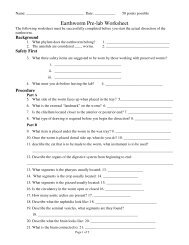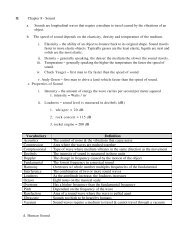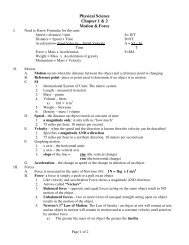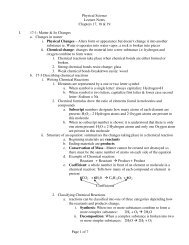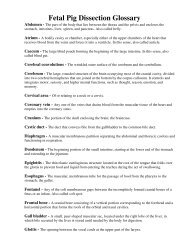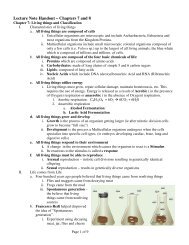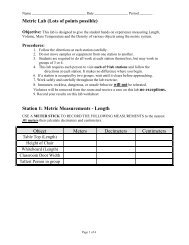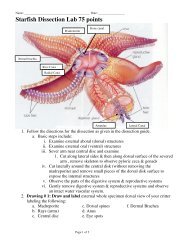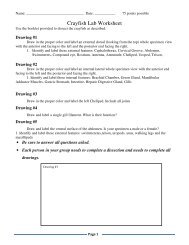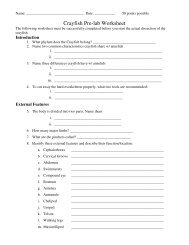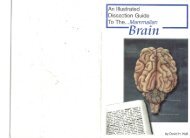Chapter 14 - Intro to Matter - Mr.E Science
Chapter 14 - Intro to Matter - Mr.E Science
Chapter 14 - Intro to Matter - Mr.E Science
You also want an ePaper? Increase the reach of your titles
YUMPU automatically turns print PDFs into web optimized ePapers that Google loves.
Physical <strong>Science</strong><br />
Lecture Notes<br />
<strong>Chapter</strong>s <strong>14</strong>, 15, 16-1 & 16-2<br />
<strong>Chapter</strong> <strong>14</strong><br />
I. Describing <strong>Matter</strong>: <strong>Matter</strong> is anything that has mass and occupies space<br />
A. Properties of <strong>Matter</strong> – How is it described: Hot, cold, hard, soft, rough, smooth, shiny, dull,<br />
solid, liquid, gas, etc.<br />
B. States of <strong>Matter</strong> – Solid, Liquid, Gas or Plasma<br />
C. Characteristic Properties – Those properties of a given substance that do not change and<br />
therefore can be used <strong>to</strong> help identify the substance.<br />
1. Boiling Point – The temperature at which a liquid changes <strong>to</strong> a vapor at or below<br />
the surface of the liquid<br />
i. Evaporation – liquid changing <strong>to</strong> a gas only at the surface of the liquid<br />
2. Melting Point – Temperature at which a solid changes <strong>to</strong> the liquid state<br />
D. Changes in <strong>Matter</strong><br />
1. Physical Change – A change that alters the form of a substance but not the<br />
chemical makeup of the substance<br />
i. Examples of physical changes – water changing from solid <strong>to</strong> a liquid or a<br />
gas, salt dissolving in a liquid, tearing a piece of paper, slicing a metal in half,<br />
chopping wood.<br />
2. Chemical Change - One or more substances combine or decompose <strong>to</strong> form a<br />
chemically different substance<br />
i. Examples – Iron rusts, wood burns, H 2 and O 2 forms water, acids react &<br />
release Hydrogen<br />
E. Types of <strong>Matter</strong><br />
1. Pure Substances – Those substances made up of one kind of matter. It has definite<br />
characteristic properties<br />
i. Examples include: Sugar, alcohol, salt, iron, copper, lead, hydrogen, oxygen<br />
ii. Two types of pure substances<br />
1. Elements<br />
a. Contain only one type of a<strong>to</strong>m,<br />
b. identified by a symbol containing a single capital letter or a<br />
two letter symbol: H for Hydrogen, Fe for iron<br />
c. can not be broken down in<strong>to</strong> other substance by chemical<br />
means<br />
d. H, He, Na, Mg, C, N, O, K, P, S, Cl, Cu, etc.<br />
2. Compounds<br />
a. A pure substance formed by the chemical combination of two<br />
or more elements<br />
b. CO 2 – Carbon dioxide, H 2 O – Water, C 6 H 12 O 6 – Glucose,<br />
NaCl – Table Salt, O 2 – gaseous Oxygen<br />
2. Mixed Substances – two or more substances that are mixed <strong>to</strong>gether but not<br />
chemically combined.<br />
i. The chemical properties of each separate substance is maintained.<br />
1. Homogeneous Mixture: a very well mixed mixture where the<br />
substances are difficult <strong>to</strong> separate, i.e. a solution of sugar water or salt<br />
water.<br />
2. Heterogeneous Mixture: a mixture where the substances are not evenly<br />
mixed, salt and pepper mixed <strong>to</strong>gether, a handful of dirt, Rocky Road<br />
Ice Cream, etc.<br />
Page 1 of 5
II. Measuring <strong>Matter</strong><br />
A. SI – International System of Units = the metric system<br />
a. Length – the one dimentional measurement of distance – SI unit is Meter, Kilometer<br />
b. Mass – the amount of matter in a substance – SI unit: gram or kilogram<br />
c. Weight – the force of gravity acting on an object – SI unit: New<strong>to</strong>n<br />
d. Volume – how much space an object occupies – SI unit: liter, milliliter, cm 3<br />
i. Volume = Length x Width x Height<br />
ii. 1ml = 1cm3<br />
e. Density – the amount of mass an object has in a given volume – SI unit: g/ml, g/cm 3<br />
i. Density= Mass / Volume<br />
f. Temperature – the average kinetic energy of an object.<br />
i. SI unit- degrees Centigrade or degrees Celcius<br />
g. Time: unit of measure: second, minute<br />
III. Particles of <strong>Matter</strong><br />
A. A<strong>to</strong>ms – The smallest particle of an Element that retains the chemical properties of that<br />
element<br />
B. Democritus – 400 BC, a Greek philosopher that coined the term “a<strong>to</strong>mos” which means<br />
uncuttable<br />
C. Dal<strong>to</strong>n – 1802, Scientist that describes the A<strong>to</strong>mic Theory<br />
a. A<strong>to</strong>mic Theory made up of 5 important points:<br />
i. A<strong>to</strong>ms can not be broken in<strong>to</strong> smaller pteces – a<strong>to</strong>ms are like a solid marble<br />
(Not entirely accurate)<br />
ii. In an element all a<strong>to</strong>ms are exactly alike (Not entirely accurate)<br />
iii. A<strong>to</strong>ms of two or more elements can combine <strong>to</strong> form compounds ( this is true)<br />
iv. A<strong>to</strong>ms of each element have a unique mass (Not entirely accurate)<br />
v. Compounds are always composed of whole number proportions of elements ie<br />
CO 2 – Carbon dioxide, H 2 O – Water, C 6 H 12 O 6 – Glucose, NaCl – Table Salt<br />
(this one is true also)<br />
D. The basic particle of an element is the A<strong>to</strong>m – H, He, Fe, etc<br />
E. The basic particle of a compound is the Molecule – a group of a<strong>to</strong>ms that are chemically<br />
bonded and act as a single unit until the bonds are broken: CO 2 , H 2 O, C 6 H 12 O 6 , NaCl<br />
F. How small are a<strong>to</strong>ms<br />
a. Sheet of paper is approx 10,000 a<strong>to</strong>ms thick<br />
b. 1 drop of water contains 2 x 10 21 a<strong>to</strong>ms of oxygen and 4 x 10 21 a<strong>to</strong>ms of Hydrogen<br />
<strong>Chapter</strong> 15 – Changes in <strong>Matter</strong><br />
I. Solid, Liquid, Gas or Plasma<br />
a. Plasma – state of matter that has had the electrons stripped away, uncommon on the<br />
Earth<br />
b. Solid – Definite Shape and Volume<br />
i. Particles (a<strong>to</strong>ms or molecules) are packed closely <strong>to</strong>gether and stay in a fixed<br />
position<br />
ii. Movement consists of vibrating particles staying in place<br />
iii. Two types of Solids<br />
1. Crystalline Solid – particles in a distinct pattern, melt at a specific distinct<br />
temperature: examples include sugar, salt, ice, quartz, etc.<br />
2. Amorphous Solid – particles arranged in an irregular pattern, therefore no<br />
real distinct melting point. As heat is applied <strong>to</strong> an amorphous solid, the<br />
substance changes from hard <strong>to</strong> softer and softer until a liquid: examples<br />
include rubber, plastic, and Eskimo pies!<br />
Page 2 of 5
II.<br />
III.<br />
c. Liquid – No shape of its own, takes on the shape of the container, but it has a definite<br />
volume<br />
i. Particles in a liquid – a<strong>to</strong>ms are loosely bound and are free flow and move, sliding<br />
easily over , under, and across each other but remaining in contact w/ one another.<br />
ii. Viscosity – resistance of a liquid <strong>to</strong> flow:<br />
1. high viscosity: slow flowing (molasses in January)<br />
2. low viscosity: fast flowing (pouring water)<br />
d. Gas – No shape of its own, takes the shape of the container it is in. No definite volume,<br />
easily compressed – More will be discussed on gases later!!<br />
Behavior of Gases<br />
a. Measuring Gases – three important measurements taken for gases. All three are closely<br />
related!! Volume Temperature and Pressure<br />
i. Volume – Gases dissipate <strong>to</strong> evenly fill the container they occupy<br />
ii. Temperature<br />
1. The measurement of the average thermal energy of the particles in the gas.<br />
2. The average speed of a gas molecule at room temperature is fast!! 500<br />
meters per second!<br />
iii. Pressure- gas particles are in constant motion and exert pressure upon the<br />
container they occupy. Because the gas particles are in motion, they collide and<br />
bounce off each other and the sides of the container. This contact w/ the sides of<br />
the container causes and outward push.<br />
1. Pressure = Force (the outward Push)<br />
Area (of the container)<br />
b. Relating Temperature and Pressure (at a constant volume)<br />
i. If the temperature increases, the added thermal energy causes the particles <strong>to</strong><br />
push harder on the inside surface of the container… this causes the pressure <strong>to</strong><br />
also go up.<br />
ii. If the temperature decreases, the pressure decreases.<br />
iii. Example: leaving a basketball outside on a cold night causes the ball <strong>to</strong> go flat<br />
c. Relating Pressure and Volume ( at a constant Temperature)<br />
i. BOYLES LAW – As pressure is increased volume will decrease, and conversely;<br />
if the pressure is decreased, the volume will increase<br />
d. Relating Volume and Temperature ( at a constant Pressure)<br />
i. Charles Law- As the temperature increases the volume will also increase;<br />
conversely, as the temperature decreases the volume will also decrease.<br />
Graphing Gas Behavior<br />
a. Graphs<br />
b. Charles Law (Temp + Volume + @ constant pressure)<br />
c. Boyles Law (Pressure + Volume - @ constant temperature)<br />
Responding Variable<br />
Manipulated Variable<br />
Page 3 of 5
IV. Physical vs Chemical Change<br />
a. Energy and Change<br />
i. Physical Change – alters the form of the substance but not its chemistry<br />
ii. Chemical Change – the substance is changed chemically in<strong>to</strong> an entirely<br />
different substance.<br />
iii. Thermal Energy – energy imparted <strong>to</strong> the moving particles, more energy causes<br />
the particles <strong>to</strong> move faster:<br />
1. higher temp = higher Thermal Energy<br />
iv. Chemical Energy – The energy s<strong>to</strong>red within the chemical bonds of the<br />
substance<br />
v. Law of Conservation of Energy: energy cannot be created or destroyed. It<br />
simply changes. The <strong>to</strong>tal energy stays the same in all reactions.<br />
b. Changes between liquid and solids<br />
i. Melting: changing from a solid <strong>to</strong> a liquid (ice melting in a glass of iced tea)<br />
ii. Freezing: changing from a liquid <strong>to</strong> a solid (water turning <strong>to</strong> ice cubes in the<br />
freezer)<br />
c. Changes between Liquid and a gas<br />
i. Vaporization: liquid changes <strong>to</strong> a gas at or below the surface of the liquid<br />
(boiling water)<br />
ii. Evaporation: liquid changing <strong>to</strong> a gas only at the surface of the liquid (a puddle<br />
drying up in the sun)<br />
iii. Condensation: gas vapor changing <strong>to</strong> a liquid (rain)<br />
d. Changes between a solid and a gas<br />
i. Sublimation: Changing from a solid directly <strong>to</strong> a gas (dry ice turns <strong>to</strong> carbon<br />
dioxide, snow “disappears” w/out melting.<br />
V. 16-1 Organizing Elements<br />
a. The periodic table is laid out by increasing a<strong>to</strong>mic number as you go across and down<br />
the table<br />
b. Main body of the table is organized in<strong>to</strong><br />
i. 18 vertical Groups or Families<br />
ii. 7 horizontal Periods<br />
c. Noble Gases - Group 18 – Non reactive, have a full compliment of valence electrons, 8<br />
and are called the “Inert Gases” because they do not react w/ other elements. Examples<br />
include Helium (very low mass and is used in filling children’s balloons and even<br />
airships and the “Goodyear Blimp) and Neon used in lighted bulbs <strong>to</strong> make a red glowing<br />
light ( a neon light).<br />
d. Halogens – Group 17 – Very reactive nonmetals w/ 7 valence electrons. Need only one<br />
more electron <strong>to</strong> fill their outer shell. Will steal an electron from a reactive metal <strong>to</strong> form<br />
ionic bonds. Examples include Chlorine (the most abundant halogen), Iodine and<br />
Bromine (found in Seawater).<br />
e. Chalogens AKA: Oxygen Family – Group 16 – nonmetals w/ 6 valence electrons, need<br />
2 electrons <strong>to</strong> fill the outer shell. Most common oxidation state is -2. Examples are<br />
Oxygen (ozone is one of its allotropes), Sulfur (responsible for that rotten egg smell<br />
when it combines w/ oxygen <strong>to</strong> form sulfur dioxide) and Selenium (one of the few<br />
non metals that are also a good conduc<strong>to</strong>r of electricity).<br />
f. The Nitrogen Family – Group 15– Elements w/ 5 valence electrons, need 3 <strong>to</strong> fill the<br />
outer shell. Examples include Nitrogen (the most abundant element in air) and Bismuth<br />
(the only metal in this family. Has a very low melting point so it is used in au<strong>to</strong>matic fire<br />
sprinkler systems) and Phosphorous (its common allotropes are red and white). Arsenic<br />
( a sometimes poisonous element that is also used extensively in medicines).<br />
Page 4 of 5
VI.<br />
VII.<br />
g. The Carbon Family – Group <strong>14</strong> – has 4 valence electrons, needs four more or needs <strong>to</strong><br />
get rid of the four it has <strong>to</strong> have none in its outer orbit. Examples include Carbon (on<br />
which all life is based) and Silicon<br />
h. The Alkali Metals – Group 1 – Very reactive metals that have only one valence electron<br />
in the outer orbit and will freely give it away <strong>to</strong> become stable. Very soft metal (you<br />
could cut it w/ a plastic knife!). They form ionic bonds w/ Halogens and Chalogens.<br />
Examples include Sodium and Potassium.<br />
i. The Alkaline Earth Metals – Group 2 – not as reactive as Alkali Metals, but still very<br />
reactive. They have two valence electrons and generally give them up <strong>to</strong> nonmetals <strong>to</strong><br />
form ionic bonds. Examples include Calcium and Magnesium<br />
j. Transition Metals – Groups 3 thru 12 – vary dramatically in reactivity, Their oxidation<br />
states vary. they are a bridge between the very reactive Alkali and Alkaline Earth Metals<br />
and the nonmetals.<br />
k. Rare Earth Elements - Lanthanides and Actinides - AKA (Inner Transition<br />
Elements). These are the bot<strong>to</strong>m two rows of the periodic table set apart from the rest of<br />
the table.<br />
16-2 Metals<br />
a. Most of the elements are metals.<br />
b. Metals tend <strong>to</strong> form positive (+) ions.<br />
c. Physical Properties<br />
i. Such as hardness, shiny, malleability (pounded in<strong>to</strong> shapes), ductility (stretched or<br />
pulled in<strong>to</strong> a wire) electrical conductivity and magnetic. Examples include<br />
Gallium that has an oxidation state of +3<br />
d. Chemical Properties<br />
i. Metals show a wide range of chemical properties.<br />
16-3 Non Metals and Metalloids<br />
a. There are 17 nonmetals, each are located <strong>to</strong> the right of the zigzag line in the periodic<br />
table.<br />
b. Non metals tend <strong>to</strong> steal electrons when they form negative (-) ions.<br />
c. Physical Properties – in general the physical properties of nonmetals are opposite those of<br />
metals. Powdery, gaseous, crumbly, non conductive, dull, not ductile or malleable.<br />
d. Chemical properties – usually form ionic bonds when combined w/ metals (NaCl, FeO 2 ,<br />
and CaC l2 ) and usually form covalent bonds when combined w/ other nonmetals (CO2,<br />
O 2 , C 6 H 12 O 6 )<br />
i. Asbes<strong>to</strong>s – substance once used for its fire retardant characteristics but is no<br />
longer used because of it’s a carcinogen.<br />
e. Even though Hydrogen (H) is located in Group 1, it is still a nonmetal and exhibits<br />
oxidation states of +1 and -1.<br />
f. Metalloids – AKA “semi metals” 7 elements on the zigzag border between metals and<br />
the non metals. Their properties will sometimes make them act like a metal and then<br />
sometimes act like a nonmetal.<br />
i. Most important characteristic is their varying ability <strong>to</strong> conduct electricity. Silicon<br />
is used <strong>to</strong> make Semiconduc<strong>to</strong>rs which are used in making computer chips.<br />
Page 5 of 5



